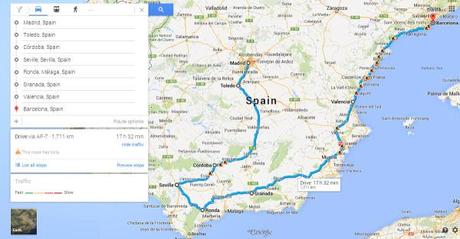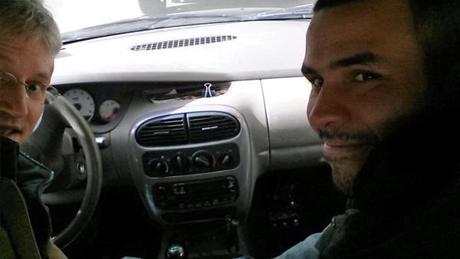
One week from today, we’re setting off on a six-month exploration of Europe. In truth, we don’t know exactly how long we’ll stay there. One thing we do know is that in six month’s time the weather will turn cold again. After enduring this past winter in the U.S. we promised ourselves we wouldn’t spend another one anywhere near a cold climate. So six months sounds like the right amount of time before we’ll want to start a southern migration.
The other thing we know is that we’re limited to 90 days in any and all Schengen area countries. After that we’ll need to exit the visa area, which encompasses most of continental Europe, for another 90 days before we can return again. We intend to spend all of our “Schengen days” this time around in Spain and France.
With our flight to Madrid fast approaching, we’ve spent these past few weeks trying to catch up on trip planning and have made some surprising, and some not so surprising, discoveries.
Trains don’t go the way you think they should
After four years of RV trip planning we’ve become conditioned to believe that the shortest distance between any two points is a straight line. We’re so used to just looking at a map, seeing what’s nearby and deciding to go that we overlooked the fact that mass transportation doesn’t always work like that.
Because of geography and ancient history, European trains don’t methodically connect all the dots on the map you might want to visit. Our first attempt at planning a Spanish itinerary, for example, had us traveling from Madrid to Barcelona in a nice orderly way.

How we thought we’d travel around Spain
Unfortunately, Spanish train tracks weren’t laid with our itinerary in mind. We couldn’t always find train service between the two cities we wanted to visit. We had less luck finding any information at all about bus routes.
So we reordered our itinerary based on Renfe train schedules and are now looking forward to a bunch more back-and-forth travel than we’d have ideally planned.

How we’ll probably have to travel around Spain
It’s possible we could have avoided all the to-and-fro had we consulted a guidebook before booking our flight into Madrid. It turns out there’s a reason they structure their itineraries the way they do. And theirs don’t typically start in Madrid. Lesson learned.
Guidebooks: 1 Pigheaded Individualism: 0
For two or more people, renting a car is less expensive than taking the train
As Americans we hear a lot about the superiority of the European rail system. What we don’t often hear about is how bloody expensive it is. It’s so expensive that it’s sometimes cheaper to fly between two European cities. What surprised us more is that renting a car is also sometimes less expensive than taking the train.
Of course which method of transportation – planes, trains or automobiles – is least costly depends a lot on your travel specifics. But for the month we’re planning to spend in France, we rented a car for less than half of what we’d spend taking the train.
We expect to stay in 13 different places while we’re in France, many of which are in rural areas we’ll want a car to explore anyway (castles, yay!). We didn’t price out train fare between each of the destinations we want to visit but did notice that a Eurail Pass allowing us just 10 trips on the train would have run us 888 Euro. Instead, we’re picking up a car in Nimes, driving it for 30 days and returning it in Rouen for 373 Euro – a 58% discount to the price of the more restrictive rail pass.
True, we’ll need to pay for gasoline and we’re “limited” to driving our car in France while the Eurail ticket permits travel in both Spain and France. We’ll also have the hassle of having to find a place to park the car while in cities. But for the cost of about $10 per person per day, we’ll have the freedom of wheels, which – we’ve found from hard experience – is something that lifts the burden of long-term travel immensely.
Drive a stick, save a bundle

Me mangling a selfie after brushing up my 20-year rusty manual transmission driving skills at the Brooklyn Driving School
I have to admit I feel like a bit of a fool. I now know that I’ve wasted hundreds, if not thousands, of dollars renting cars on previous European vacations. I don’t even recall giving it much thought. I simply rented an automatic transmission because that’s what we drive here in the states.
But that’s not what they drive in Europe. There almost everyone drives a stick. And that cultural difference shows up in both the price and availability of rental cars in Europe. Assuming you can even find an automatic transmission vehicle to rent, it will cost you two or three times more than your cheapest manual option.
If you don’t know how to drive manual transmission, it’s worth finding a friend or a local driving school to teach you.
Hostels aren’t always the cheapest lodging options
Hostels have come a long way in recent years and so too have their prices. Instead of just offering basic, dorm-room type accommodations to kids, many hostels have made a big push into more upscale markets. So much so that it’s not uncommon to hear the once-oxymoronic term “luxury hostel” used with a straight face.
Now “hostel” type luxury still isn’t the Four Seasons. You won’t get mints on your pillow or marble lobbies. But private “ensuite” rooms suitable for, ahem, older couples like ourselves are now pretty common. And along with those private rooms you get amenities that the Four Seasons can’t touch – like full working kitchens, daily organized activities, and common rooms teeming with other travelers eager to share their tales and their local tips.
At the Al-Andalus Hostel in Granada, for example, we’ll be checking out the wares in their wine cellar. And at the Sevilla Backpackers Inn, we’ll be taking a paella-making class and sipping sangria on a roof deck with views of the Royal Alcazar palace and a cathedral.
These places cost us about $10 more per night than competing budget hotels in the area, but we figure the better atmosphere and activities make it easily worth the price.
Stuff books up early

If we sound a little like a broken record about the virtues of advance planning it is because every time we turn around something we want to do is booking up on us. The most recent example is Spain’s Alhambra Palace.
If there is any single place on our European agenda that we’re absolutely dying to visit, the Alhambra is it. And if we tried to book Alhambra tickets today for the days we expect to be in town – a full month from now, in the middle of the week, and still in the off-season – we’d find them sold out. Had we not grabbed tickets a couple of nights ago we’d be in a bit of a panic right now.
Of course in the case of the Alhambra we might still be able to get tickets by paying triple for a private tour. Or we could pay double and get a Granada City Pass that also includes tickets to the Alhambra. But we’re really not about paying double and triple for things (except car rentals, apparently). And there’s no guarantee that even those options will remain open indefinitely.
Cars in Europe are going fast as well. Fewer rental companies are offering automobiles for the month of May today than when we booked ours two weeks ago. And prices for those remaining vehicles have risen by about $100 since then.
Hotels in Normandy for early June are also hard to come by. According to Booking.com, the city of Bayeux and the surrounding area is 94% booked for the weekend of June 6; two and a half months ahead of time.
We’re told we need to start booking now if we want to hit Oktoberfest this fall.
Of course not everywhere is so overrun. We’re still finding plenty of great and inexpensive hotel options in places like Toledo, Spain, just a couple of weeks before we arrive.
But the problem we face is that we can’t tell which things need to be booked ahead until we have some idea where we’re going to be and when we’re going to be there. And knowing those things really does require a fair amount of advance planning.

